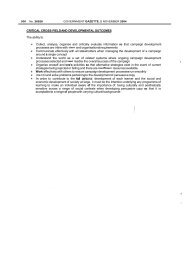The trafficking of children for purposes of sexual exploitation
The trafficking of children for purposes of sexual exploitation
The trafficking of children for purposes of sexual exploitation
Create successful ePaper yourself
Turn your PDF publications into a flip-book with our unique Google optimized e-Paper software.
Article 7 places an obligation on state parties 'to take all appropriate measures to ensure the<br />
effective implementation and en<strong>for</strong>cement' <strong>of</strong> the clauses and provisions in this Convention.<br />
Necessary steps should be taken to 'prevent the engagement <strong>of</strong> <strong>children</strong> in the worst <strong>for</strong>ms <strong>of</strong> child<br />
labour' as outlined in Section 7(2)(a).<br />
It also highlights the States' responsibilities to implement rehabilitative measures and initiatives<br />
aimed at the social integration <strong>of</strong> survivors <strong>of</strong> harmful <strong>for</strong>ms <strong>of</strong> child labour. <strong>The</strong> Convention states<br />
in Section 7(2)(b) that States have an obligation<br />
to provide the necessary and appropriate direct assistance <strong>for</strong> the removal <strong>of</strong> <strong>children</strong> from the<br />
worst <strong>for</strong>ms <strong>of</strong> child labour and <strong>for</strong> their rehabilitation and social integration.<br />
In addition, in Section 7(2)(d) and 7(2)(e) the Convention strongly emphasises the need <strong>for</strong> states<br />
to take 'effective and time-bound measures' to 'identify and reach out to <strong>children</strong> at special risk; and<br />
take account <strong>of</strong> the special situation <strong>of</strong> girls'.<br />
Despite the importance that Article 7 gives to the responsibility that States have <strong>for</strong> the<br />
rehabilitation and social integration <strong>of</strong> child survivors, its strongest emphasis is placed on measures<br />
intended to prevent child labour in its worst <strong>for</strong>ms from taking place. This means that it is <strong>of</strong> the<br />
utmost importance to take all measures, including education and awareness raising, to eradicate<br />
harmful child labour.<br />
In the context <strong>of</strong> <strong>trafficking</strong> <strong>of</strong> <strong>children</strong> <strong>for</strong> <strong>purposes</strong> <strong>of</strong> <strong>sexual</strong> <strong>exploitation</strong> this would certainly<br />
translate into introducing <strong>trafficking</strong> legislation making direct or indirect involvement in such<br />
<strong>trafficking</strong>, as well as any activity that facilitates, enables, or ensures <strong>children</strong>'s <strong>sexual</strong> <strong>exploitation</strong>,<br />
a criminal <strong>of</strong>fence.<br />
3. Continental Charters<br />
South Africa has signed both the African Charter <strong>of</strong> Human and People's Rights and the African<br />
Charter on the Rights and Welfare <strong>of</strong> the Child. In so doing South Africa committed itself to protect<br />
<strong>children</strong> from exploitative and harmful practices, which place their safety and well being at risk.<br />
• African Charter on Human and People's Rights (1981)<br />
<strong>The</strong> Charter came into <strong>for</strong>ce in 1986. South Africa ratified the Charter in 1996. In terms <strong>of</strong> Article 5<br />
South Africa is obligated to prohibit all <strong>for</strong>ms <strong>of</strong> <strong>exploitation</strong> and degradation and in particular<br />
slavery and the slave trade. Article 18(2) obligates South Africa to ensure "the elimination <strong>of</strong> every<br />
discrimination against women and ... the protection <strong>of</strong> the rights <strong>of</strong> the woman and the child as<br />
stipulated in international declarations and conventions." This stipulation places a further<br />
obligation on South Africa to adhere to its obligations in terms <strong>of</strong> UN Conventions and Declarations<br />
and ILO instruments.<br />
• African Charter on the Rights and Welfare <strong>of</strong> the Child (1990)<br />
South Africa signed the African Charter on the Rights and Welfare <strong>of</strong> the Child in 1996. <strong>The</strong><br />
Charter has been ratified by only six member states <strong>of</strong> the Organisation <strong>for</strong> African Unity and as<br />
such is not yet in <strong>for</strong>ce (15 ratifications are required to en<strong>for</strong>ce the Charter). <strong>The</strong> Charter contains<br />
provisions related to the rights and responsibilities <strong>of</strong> <strong>children</strong>. It contains provisions to deal with<br />
the <strong>sexual</strong> <strong>exploitation</strong>, and the sale and <strong>trafficking</strong> <strong>of</strong> <strong>children</strong>. <strong>The</strong>se provisions while in essence<br />
similar to provisions in the CRC contain a number <strong>of</strong> additional aspects.<br />
Article 16 <strong>of</strong> the African Charter protects <strong>children</strong> against abuse and torture and its wording is<br />
identical to Article 19 <strong>of</strong> UN CRC. It imposes the obligation on State Parties to<br />
Take specific legislative, administrative, social and educational measures to protect the child from<br />
all <strong>for</strong>ms <strong>of</strong> torture, inhuman or degrading treatment and especially physical or mental injury or<br />
abuse, neglect or maltreatment including <strong>sexual</strong> abuse, while in the care <strong>of</strong> the child.<br />
71
















